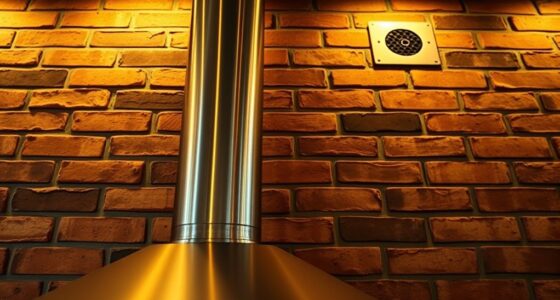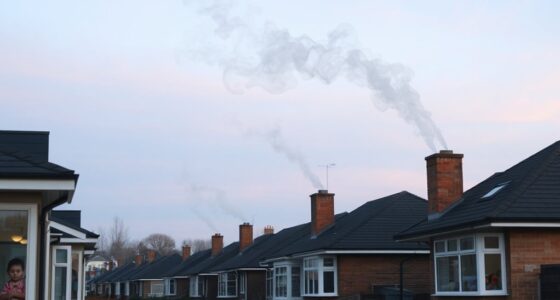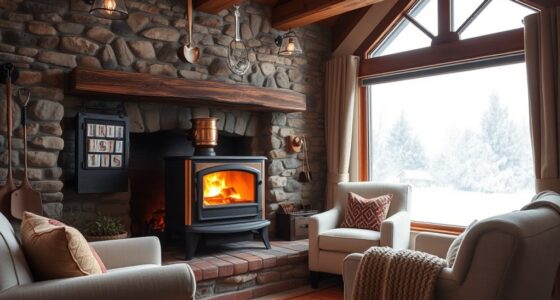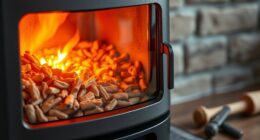Backdrafting happens when your home’s vents or chimneys don’t work properly, causing dangerous gases to flow back inside instead of escaping. This usually occurs due to poor ventilation, blocked vents, or improper appliance placement that creates negative pressure. To fix this, make certain vents are clear, properly installed, and maintained regularly. Correctly balancing your ventilation system and following safety codes helps prevent backdrafting. Keep going to discover how to prevent and address these hazards effectively.
Key Takeaways
- Backdrafting occurs when indoor combustion gases re-enter the building due to negative pressure caused by ventilation issues.
- Causes include blocked or malfunctioning vents, improper appliance placement, and insufficient outdoor air supply.
- Regularly inspecting and maintaining vents, chimneys, and appliances helps prevent backdrafting.
- Ensuring proper appliance placement and following building codes improves venting efficiency and safety.
- Correcting ventilation problems and consulting professionals can effectively fix and prevent backdrafting hazards.

Backdrafting occurs when combustion gases flow back into a building instead of venting outside, often causing dangerous smoke or fire to re-enter the space. This phenomenon can be deadly because it introduces toxic gases and smoke into areas where people live and work. To prevent backdrafting, you need to understand the role of ventilation issues and appliance placement. These factors directly influence how well a building’s ventilation system works and whether combustion gases can escape safely.
Backdrafting risks arise from poor ventilation and improper appliance placement, threatening indoor safety and air quality.
One common cause of backdrafting is poor ventilation. When a building’s ventilation system isn’t functioning correctly, it can create negative pressure inside the space. Negative pressure occurs when more air is being exhausted than is being supplied, which can suck combustion gases back through vents or chimneys. You might notice this happening near exhaust fans, clothes dryers, or range hoods that are improperly vented or blocked. If these appliances are not installed correctly or if their vents are clogged, it can disrupt the airflow, making it easier for gases to be pulled back into the building rather than vented outside.
Appliance placement plays a significant role in preventing backdrafting. If combustion appliances like furnaces, water heaters, or fireplaces are located too close to exhaust vents or in poorly ventilated areas, they can contribute to venting problems. For example, when a furnace is placed in a confined space with limited airflow, the buildup of combustion gases becomes more likely. Additionally, if these appliances are installed in a way that their vents are obstructed or poorly designed, it can hinder proper exhaust flow. Proper appliance placement involves ensuring enough clearance around vents and that they are directed outside in a way that promotes smooth airflow. This helps gases escape quickly and reduces the chances of them reversing direction and entering the living space. Regular maintenance and inspections can help identify potential issues before they lead to backdrafting incidents.
To fix ventilation issues and improve appliance placement, start by inspecting all vents and chimneys regularly. Keep vents clear of debris, nests, or blockages that could impede airflow. When installing new appliances, follow manufacturer guidelines for placement and venting. It is also beneficial to consider building codes and standards to ensure safety compliance and optimal ventilation design. If you notice signs of backdrafting, such as odors, smoke, or poor indoor air quality, consider consulting a professional to evaluate your ventilation system and appliance setup. Properly balanced ventilation and correct appliance placement work together to ensure that combustion gases are safely vented outside, preventing backdrafting and safeguarding your indoor air quality. Being proactive about these factors can save lives and protect your home from the hazards associated with backdrafting. Ensuring proper ventilation systems and appliance placement can significantly reduce the risk of dangerous backdrafting issues.
Frequently Asked Questions
Can Backdrafting Occur in All Types of Homes?
Backdrafting can occur in many types of homes, especially if your home design lacks proper ventilation systems. Poorly ventilated spaces trap combustion gases, increasing the risk when a vent or flue is blocked or not functioning correctly. You should regularly check your ventilation systems and make certain of proper airflow. Properly designed homes reduce backdrafting risks, so maintaining good ventilation is key to keeping your home safe from dangerous gases.
How Quickly Does Backdrafting Typically Develop?
Backdrafting can develop quickly, often within minutes if conditions are right. The draft timing depends on factors like ventilation, airflow, and the presence of combustible gases. You might notice sudden smoke or flames pushing back into the room, signaling rapid development. It’s vital to stay alert, especially if you see signs of poor ventilation or a strong odor of gas, as backdrafting can occur unexpectedly and escalate swiftly.
Are Certain Weather Conditions More Likely to Cause Backdrafting?
Certain weather factors, like high winds and low barometric pressure, increase the risk of backdrafting. These conditions can disrupt your home’s ventilation, trapping combustion gases indoors. When outdoor air pressure drops or wind pushes air into vents, it can cause dangerous backdrafts. To prevent this, guarantee proper ventilation and be mindful of weather changes that could compromise your home’s safety, especially during storms or windy days.
What Are the Warning Signs of Imminent Backdrafting?
You’re on the edge of danger when you notice strange odors or a smoke alarm suddenly shrieking. These are warning signs of imminent backdrafting, like a warning siren before a storm. Keep an eye out for thick, smoky air lingering, or windows that stay closed despite heat. If you see these signs, ventilate immediately and turn off your appliances. Acting fast can prevent a fiery explosion.
Is Professional Intervention Always Required to Fix Backdrafting?
You shouldn’t assume professional intervention is always necessary to fix backdrafting. If you notice ventilation issues or detect carbon monoxide risks, it’s vital to consult a professional. They have the expertise to properly assess and address the problem, guaranteeing your safety. Ignoring these signs can lead to dangerous buildup of gases, so getting expert help minimizes risks and guarantees the ventilation system operates correctly, preventing future backdrafting.
Conclusion
If you ignore backdrafting, you’re risking an explosion that could level your entire home and turn your peaceful space into a fiery inferno. It’s like opening Pandora’s box—once it’s out, you can’t control the chaos. But don’t panic! By understanding the causes and applying simple fixes, you can keep your home safe from this disaster. Take action now, or prepare to face a nightmare that’ll haunt you forever.










